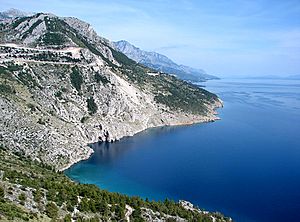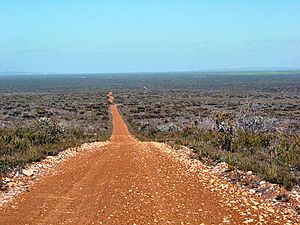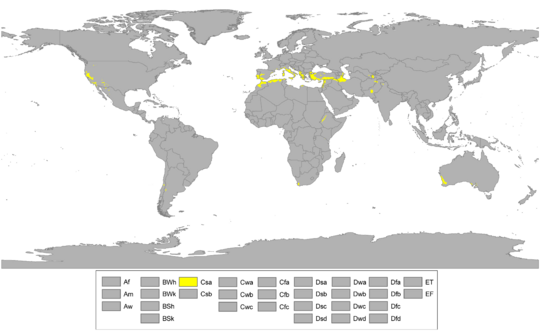Mediterranean climate facts for kids
A Mediterranean climate is a special type of climate that has dry, warm, or hot summers. Its winters are cool or mild, with a good amount of rain. This climate is found in many places around the Mediterranean Sea. Outside of that area, you can find it in smaller regions, usually between 30° and 45° north and south of the equator.
Many big, old cities near the Mediterranean Sea, like Athens, Rome, and Barcelona, have this climate. Major cities far from the Mediterranean also have it, such as Cape Town, Los Angeles, and Perth. Some local winds affect the northern Mediterranean, like the Bora, Mistral, and Sirocco. The Bora is a cold, dry wind that brings clear skies, often causing damage to crops.
Contents
Where You Find It
Besides the area around the Mediterranean Sea, you can find this climate in other parts of the world. These include the coastal areas of the Western United States (like near Los Angeles), the Western Cape in South Africa, central Chile, and parts of southern and western Australia.
How Rain Falls
It [Chile] has six, months of winter, no more, and in them, except when there is a quarter moon, when it rains one or two days, all the other days have such beautiful suns...
During summer, Mediterranean climate regions are very dry. This is because cold ocean currents keep the weather stable and sunny. Like in desert climates, summer days can be very hot, but nights cool down quickly.
In winter, these regions are no longer affected by the cold ocean currents. Warmer water near the land causes clouds to form, bringing more rain. So, most of the rain in these areas falls during winter and spring. Summers can go for 3 to 6 months with very little rain. Places closer to the Horse latitudes get less rain overall. Areas closer to the poles, like Southern Europe, usually get more rain. In places like Southern California, summers are almost completely dry.
Temperatures
Most Mediterranean climate regions have mild winters and very warm summers. But temperatures can be quite different from one region to another. For example, Valencia and Los Angeles have mild winters with almost no frost or snow. But Tashkent has colder winters with regular frost and snow.
For summers, Athens can get very hot, with temperatures sometimes reaching 48°C (118°F). In contrast, San Francisco has cool summers, with daily highs around 21°C (70°F). This is because cold water from deep in the ocean rises to the surface along the coast.
Because most Mediterranean climate areas are near large bodies of water, temperatures are usually moderate. This means there isn't a huge difference between winter lows and summer highs. However, summer days can have big temperature changes between day and night due to clear, dry conditions. Winter temperatures rarely drop below freezing, and snow is uncommon. Summer temperatures can range from mild to very hot, depending on how close they are to water, their elevation, and their latitude. Even in the warmest spots, temperatures usually don't get as high as in nearby deserts, thanks to the cooling effect of the water. But strong winds from inland deserts can sometimes make summer temperatures rise quickly, increasing the risk of wildfires.
Higher areas in Mediterranean regions can have cooler winters than lower areas. These cooler temperatures can sometimes stop typical Mediterranean plants from growing.
Mediterranean Biome


The Mediterranean forests, woodlands, and scrub biome is strongly linked to Mediterranean climate zones. These areas have unique plant life, especially sclerophyll shrublands. These are called maquis around the Mediterranean Sea, chaparral in California, matorral in Chile, fynbos in South Africa, and mallee and kwongan shrublands in Australia.
Plants and animals in streams and rivers in these regions are used to a yearly cycle. During floods, the environment controls what lives there. As water levels drop, living things like competition and hunting become more important. When it gets very hot and dry, the environment takes over again. Because of this, these communities are good at recovering from droughts, floods, and fires.
Natural Plants
The native plants in Mediterranean climate lands must be able to survive long, hot summer droughts and long wet periods in winter. Here are some examples of Mediterranean plants:
- Evergreen trees: like bay laurel, pine, and cypress
- Deciduous trees (lose leaves): like sycamore, oak, and buckeyes
- Fruit trees: like olives, figs, walnuts, and grapes
- Shrubs: rosemary, Erica, Banksia, and chamise
- Small shrubs: like lavender, Halimium, and sagebrush
- Grasses: grassland types, Themeda triandra, bunchgrasses; sedges, and rushes
- Herbs: like Achillea, Dietes, Helichrysum, and Penstemon
Many native plants in Mediterranean valleys have been cleared for farming. In places like the Sacramento Valley in California, draining wet areas and adding irrigation has led to a century of intense farming. Much of the Overberg in South Africa has also been turned into farmland, mostly for wheat. In hills and mountains, away from cities, native plant ecosystems are better preserved.
The fynbos plants in South Africa are famous for their huge variety of flowers. This includes plants like Restionaceae, Erica (Heaths), and Proteas. Proteaceae plants also grow in Australia, like Banksias. The native plants of California are also known for their many different species and types.
Hot-Summer Mediterranean Climate
This type of Mediterranean climate (called Csa) is the most common. It's often called a "typical Mediterranean climate." In these regions, the average temperature in the warmest month is above 22.0°C (71.6°F). The coldest month's average temperature is between 18°C (64°F) and −3°C (27°F) (or 0°C/32°F in some definitions). Also, at least four months must have an average temperature above 10°C (50°F).
Regions with this climate usually have hot, sometimes very hot, and dry summers. Their winters are mild and wet. In some cases, summers can be very similar to those in dry and semi-arid climates. However, summer high temperatures are generally not as extreme as in deserts because of the nearby large body of water. All areas with this subtype have wet winters. Some places with a hot Mediterranean subtype can even have very chilly winters with occasional snowfall.
Csa climates are mainly found around the Mediterranean Sea, southwestern Australia, southwestern South Africa, parts of Central Asia, northern parts of Iran and Iraq, and inland areas of northern California and southern Oregon. The coasts of Southern California also have hot summers because the Channel Islands block some of the cooling ocean influence. However, coastal areas without this protection can have warm-summer Mediterranean climates, with hot-summer areas just a few miles inland.
Images for kids
-
Agean Sea of Ölüdeniz, Turkey
See also
 In Spanish: Clima mediterráneo para niños
In Spanish: Clima mediterráneo para niños






